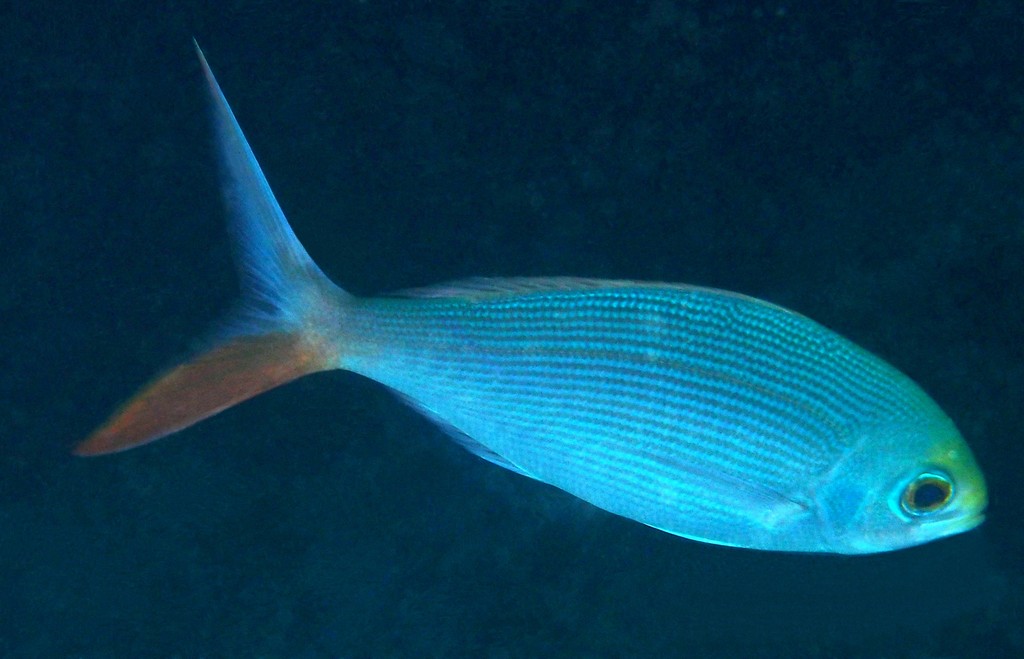PARACAESIO SORDIDA - (ABE & SHINOHARA, 1962)
Actinopterygii (Gigaclass) > Actinopteri (Class) > Teleostei (Subclass) > Acanthuriformes (Order) > Lutjanidae (Family) > Apsilinae (Subfamily) > Paracaesio (Genus)
Vivanette bleue, Sordid snapper, Blue snapper, Smallscale snapper, Dirty ordure snapper, Panchote azul, Yogore-aodai, ヨゴレアオダイ, 冲绳若梅鲷, 梭地擬烏尾鮗,
Synonymes
Paracaesio soldidus (Abe & Shinohara, 1962)
Paracaesio sordidus (Abe & Shinohara, 1962)
-------------------------
Description
Dorsal spines (total): 10; Dorsal soft rays (total): 10; Anal spines: 3; Anal soft rays: 8-9 (usually: 8); Pectoral fin rays: 16 (usually: 17); Tubed lateral line scales: 69-72. Body moderately deep, laterally compressed, body depth 2.5-2.7 in SL. Nostrils on each side of snout close together. Mouth terminal, jaws about equal. Anterior end of upper lip without a thick fleshy protrusion. Premaxillae protrusible. Maxilla reaching vertical through anterior part of eye. Both upper and lower jaws with an outer row of conical teeth (some of these enlarged into caniniform teeth anteriorly) and with an inner band of very small teeth; Vomer and palatines with very small teeth, those on vomer in a triangular or chevron-shaped patch; No teeth on tongue. Maxilla without scales or longitudinal ridges. Interorbital region convex. First gill arch with 9-11 gill rakers on upper limb, 19-24 on lower limb (total 28-34). Dorsal fin continuous, not deeply incised near junction of spinous and soft portions. Last soft ray of dorsal and anal fins not produced, shorter than next to last ray. Caudal fin deeply forked. Pectoral fins long, usually longer than head. Membranes of dorsal and anal fins without scales. Preopercle with 1-3 rows of scales peripheral to and usually distinctly separated from main group of cheek scales. Max. length: 48.0 cm TL, common length: 27.5 cm SL. Depth range: 5 - 200 m.
Color
Overall dark grey, dark purplish brown, dark violet, or bluish; Lower sides and belly about as dark as overall coloration, silvery, or whitish; Fins variable: dark grey, reddish brown, or dorsal and caudal fins brownish to slightly yellow with other fins mostly whitish to translucent.
Etymology
Paracaesio: from Greek prefix, para- = resembling to + from Latin, caesius = blue-grey or bluish-grey. It is the same name given to the silvery metal (Cs).
sordida: from Latin, sordidus = dirty, filthy. Referring to deep-violet body color with deep-brown fins in life (dark-brown all over in alcohol).
Original description: Paracaesio sordidus Abe & Shinohara, 1962 - Type locality: Okinawa Island, Ryukyu Islands, Japan.
Distribution
Red Sea; Indo-West Pacific: Aliwal Shoal (South Africa), Seychelles, Comoros, Madagascar and western Mascarenes (La Pérouse Seamount) east to Marquesas Islands (French Polynesia) and Pitcairn Group, north to Ryukyu Islands (Japan), south to New Caledonia.
Biology
Adults are found over rocky bottoms often in schools. They feed on plankton. Caught mainly with handlines, but in relatively low numbers. An important food fish in some areas. Usually marketed fresh.
Vivanette bleue, Sordid snapper, Blue snapper, Smallscale snapper, Dirty ordure snapper, Panchote azul, Yogore-aodai, ヨゴレアオダイ, 冲绳若梅鲷, 梭地擬烏尾鮗,
Synonymes
Paracaesio soldidus (Abe & Shinohara, 1962)
Paracaesio sordidus (Abe & Shinohara, 1962)
-------------------------
Description
Dorsal spines (total): 10; Dorsal soft rays (total): 10; Anal spines: 3; Anal soft rays: 8-9 (usually: 8); Pectoral fin rays: 16 (usually: 17); Tubed lateral line scales: 69-72. Body moderately deep, laterally compressed, body depth 2.5-2.7 in SL. Nostrils on each side of snout close together. Mouth terminal, jaws about equal. Anterior end of upper lip without a thick fleshy protrusion. Premaxillae protrusible. Maxilla reaching vertical through anterior part of eye. Both upper and lower jaws with an outer row of conical teeth (some of these enlarged into caniniform teeth anteriorly) and with an inner band of very small teeth; Vomer and palatines with very small teeth, those on vomer in a triangular or chevron-shaped patch; No teeth on tongue. Maxilla without scales or longitudinal ridges. Interorbital region convex. First gill arch with 9-11 gill rakers on upper limb, 19-24 on lower limb (total 28-34). Dorsal fin continuous, not deeply incised near junction of spinous and soft portions. Last soft ray of dorsal and anal fins not produced, shorter than next to last ray. Caudal fin deeply forked. Pectoral fins long, usually longer than head. Membranes of dorsal and anal fins without scales. Preopercle with 1-3 rows of scales peripheral to and usually distinctly separated from main group of cheek scales. Max. length: 48.0 cm TL, common length: 27.5 cm SL. Depth range: 5 - 200 m.
Color
Overall dark grey, dark purplish brown, dark violet, or bluish; Lower sides and belly about as dark as overall coloration, silvery, or whitish; Fins variable: dark grey, reddish brown, or dorsal and caudal fins brownish to slightly yellow with other fins mostly whitish to translucent.
Etymology
Paracaesio: from Greek prefix, para- = resembling to + from Latin, caesius = blue-grey or bluish-grey. It is the same name given to the silvery metal (Cs).
sordida: from Latin, sordidus = dirty, filthy. Referring to deep-violet body color with deep-brown fins in life (dark-brown all over in alcohol).
Original description: Paracaesio sordidus Abe & Shinohara, 1962 - Type locality: Okinawa Island, Ryukyu Islands, Japan.
Distribution
Red Sea; Indo-West Pacific: Aliwal Shoal (South Africa), Seychelles, Comoros, Madagascar and western Mascarenes (La Pérouse Seamount) east to Marquesas Islands (French Polynesia) and Pitcairn Group, north to Ryukyu Islands (Japan), south to New Caledonia.
Biology
Adults are found over rocky bottoms often in schools. They feed on plankton. Caught mainly with handlines, but in relatively low numbers. An important food fish in some areas. Usually marketed fresh.
Last update: 23, March 2023
